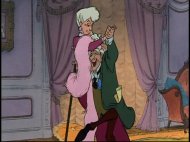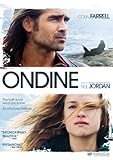[easyazon-image align=”left” asin=”B000LXWAI6″ locale=”us” height=”160″ src=”http://ecx.images-amazon.com/images/I/51rxIYJwWKL._SL160_.jpg” width=”114″]
[easyazon-link asin=”B000LXWAI6″ locale=”us”]Padre Pio Miracle Man[/easyazon-link], distributed by Catholic publishing company Ignatius Press, gets high marks for its attempt to present the cinematic endeavor in more than one language and to include subtitles for each language with which the movie is dubbed. The English-language soundtrack is the victim of some stilted English expression, unfortunately complementing some stilted acting.
One reviewer on Amazon.com recommends using the Italian soundtrack in combination with the English subtitles (fortunately, a technical possibility).
The movie presents a version of Padre Pio’s life story largely told in flashbacks at the behest of another priest who is engaging in the (to some) extraordinary effort of investigating (and, at times, interrogating) Padre Pio in the later years of his life. The investigating priest is seen to use a cane, but in spite of having a mobility impairment himself, ignores Padre Pio’s obvious fatigue during the series of interviews. Padre Pio is depicted in the film as intermittantly using an oxygen tank in old age, and occasionally a manual wheelchair. It would seem he had a generalized weakness in later life, but he was still sufficiently ambulatory to celebrate mass, and to be censured by his religious superiors for taking three hours to do so.
When Padre Pio was a child growing up in the Catholic Church, he witnessed a woman in his church praying to St. Peregrine to cure her young son, whom she held in her arms. Growing increasingly frustrated, she left the boy, who appeared to be five or six years old, and initially seemed spastic, but later was depicted as unconscious, at the altar of the church, whereupon, either through the gesture of “leaving him to God/the Church” just below the altar steps, or the mental focus of the young Francisco (later to become Pio) silently and more directly imploring the help of God for the boy, the boy regained consciousness, and got up and walked. The movie did not specify what, exactly, the boy had, but St. Peregrine is the patron saint of cancer sufferers.
While this cinematic retelling of significant events in the life of Padre Pio adheres to the Catholic tradition of equating suffering with holiness by depicting Padre Pio’s more mundane health conditions as well as his receiving of the stigmata, and how Pio and the religious authorities of his time and place dealt with it, it also shows that Padre Pio had a long and active life in spite of some chronic conditions.
When Pio was of military age, he was ordered to report to his draft board for a physical examination, in spite of his status as clergy, for which he should have been given an exemption. Nevertheless, upon having actually submitted to physical examination, he was spared military service by doctors who were seen to examine his chest X-Ray, and to reject him for military service, on the grounds that he would “infect the whole unit”, the implication being that he had tuberculosis.
Indeed, it was because of the fact that people sought him out and Padre Pio developed a considerable and devoted following during his lifetime, that it was a reasonable concern to orthodox Catholicism that because of his influence, people were coming back to the church for the wrong reasons, or more precisely, that they were coming to Padre Pio, because of what would today be termed mediumistic or psychic powers (also said by occultists outside the church to at times be accompanied or caused by a declining physical body). When asked how he was able to know certain things in advance of their actual occurence, Padre Pio gave an answer surprisingly similar to Cayce’s concept of the Akashic Records; “sometimes God allows me a look at his notebook”.
It was perhaps with this and his public influence in mind that Padre Pio’s religious superiors had him effectively held prisoner for a period of time.
The movie does a good job of showing that some miraculous occurrences attributed to Padre Pio may have had alternative explanations not involving the supernatural or the power of God, such as Pio’s ability to tell people who came to him for news about relatives in military service: the priest who questioned him about his life said that it was “the law of averages” which allowed him to predict the fate of soldiers to their loved ones with some degree of accuracy.
However, some other things are left open to belief, such as one incident in which Pio was established to have successfully bilocated in order to be on the scene during a combat incident during the war, and give a dying soldier last rites, while the other priest shrank from going forward to do so, gun shy because the soldier had been killed by a flying bullet and there was still shooting. There was another incident in which he barred the door against a mortally wounded soldier seeking absolution (within the context of Last Rites) because he was afraid for his own safety.
Though the movie dealt with some miracles said to have been committed by Padre Pio, it left out other reputed supernatural abilities, including the fact that at one point in his life, Padre Pio, like some other stigmatics, manifested the phenomenon of inedia.
Padre Pio was said to have survived on nothing but the Blessed Sacrament and an occasional beer. Whether such a feat was truly miraculous is open to more than one interpretation, like many of Padre Pio’s other unusual abilities depicted in the movie. If Padre Pio remained in his bed or wheelchair for most of the day, it may well be that he had few caloric needs at that time of his life. (And everyone knows that beer is full of empty calories!)






